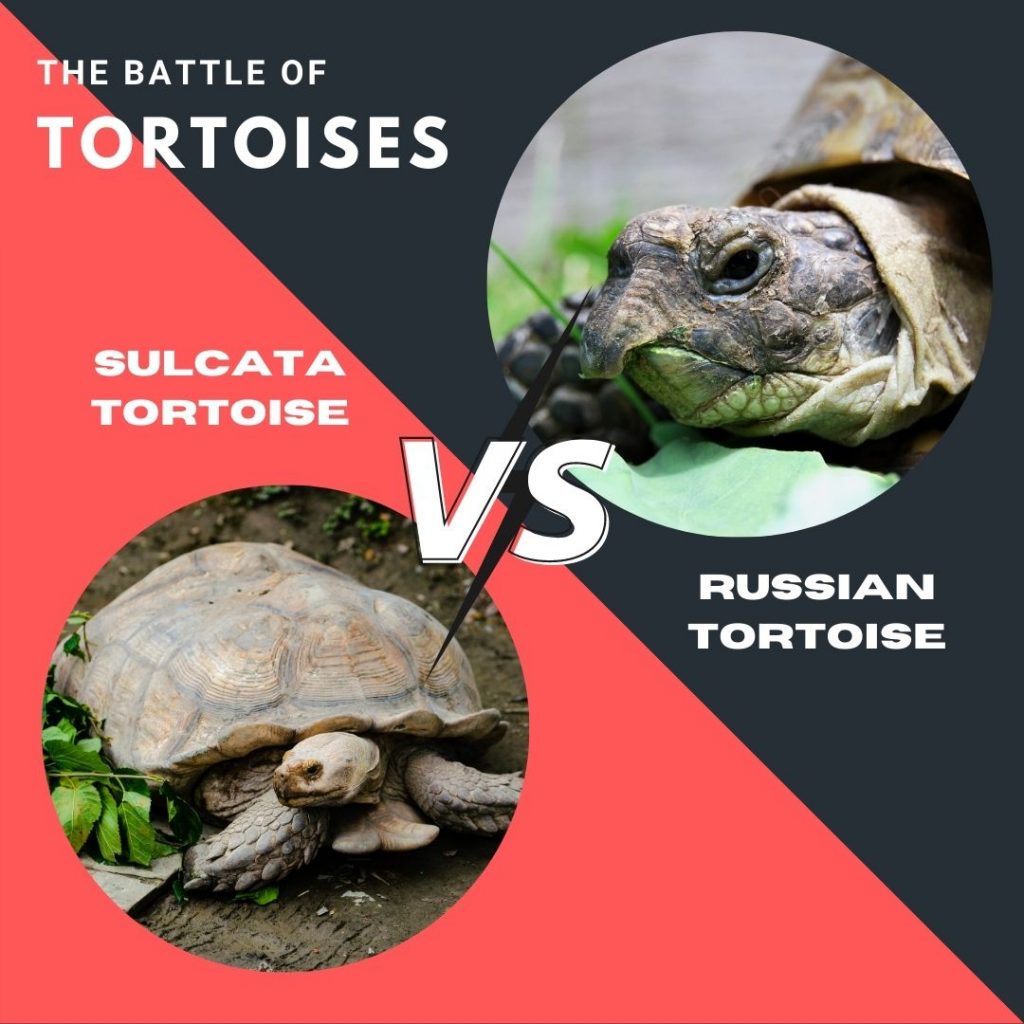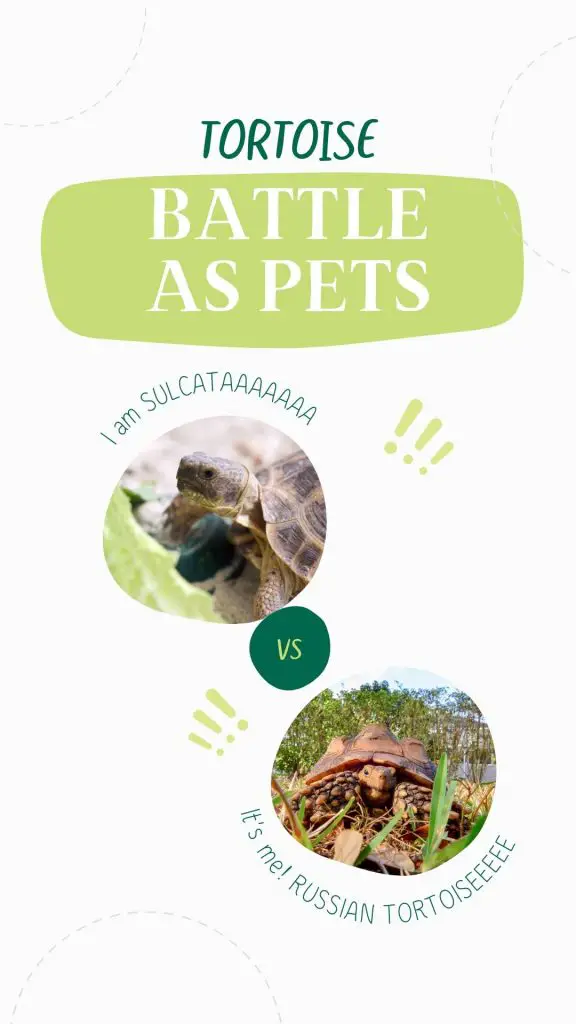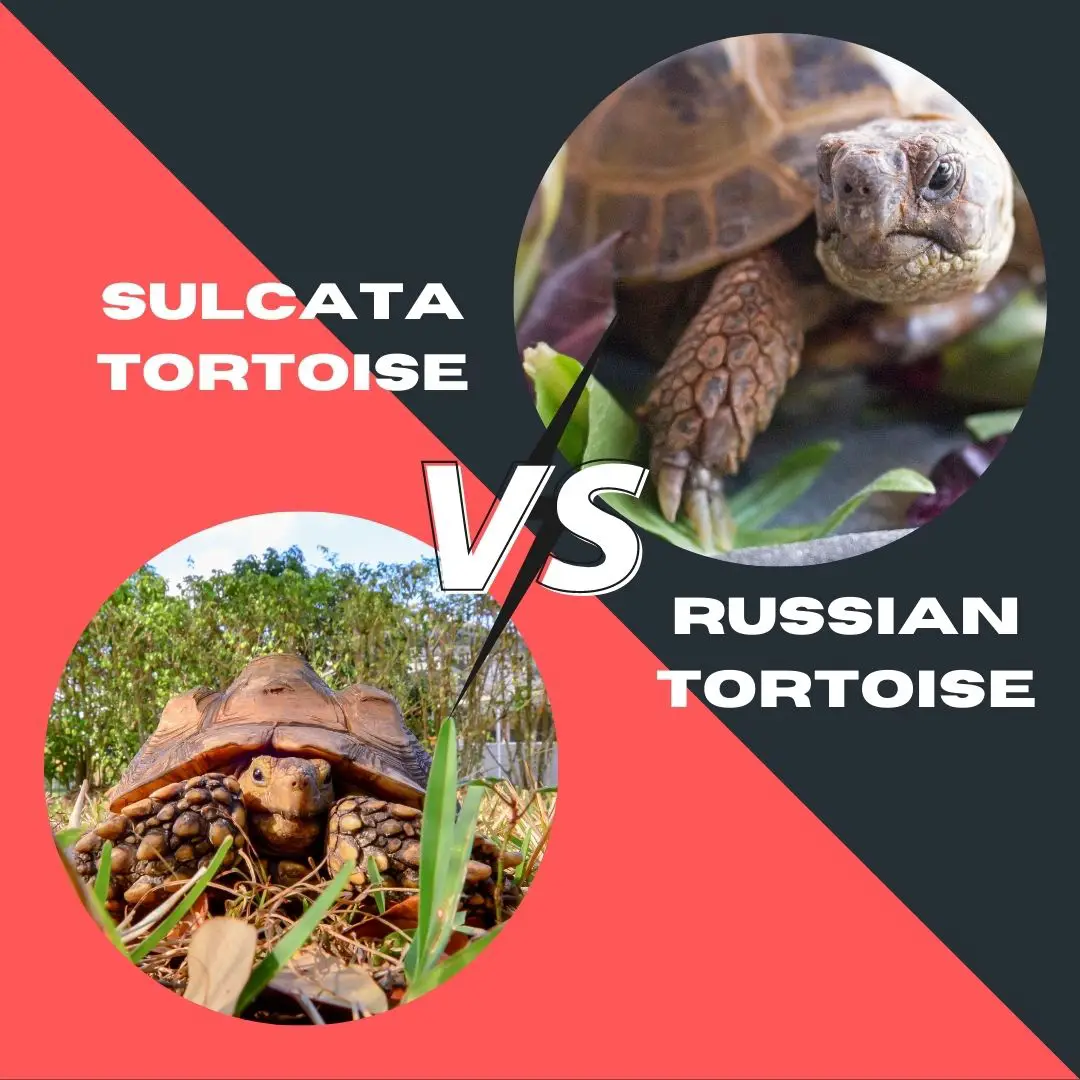If you’re an exotic pet lover who is tired of lizards, dogs, or even cats, then you might want to try tortoises. Of all the different species of tortoises, sulcata and Russian species are the most popular and commonly owned species as pets.
Unfortunately, these two species of tortoises make different options which most times left pet enthusiasts confused on which species to go for. But on a closer look, they have similar ‘easy to care for’ requirements.
While it’s inevitable for you to fall in love with a baby sulcata tortoise, you’re likely going to feel disappointed with its large size in about 50 years of age or less.
On the flip side, Russian tortoises, although would grow big, you can still manage its size within your home.
Apart from their sizes, what other differences or similarities do sulcata and Russian tortoises have? Let’s find out.
The aim of this article is not only to tell you what these two species of tortoises share in common or how they differ but to help you know these tortoises and make the best decision on which species to go for as a pet.
Contents
Sulcata vs Russian Tortoise As Pets

Both sulcata and Russian tortoises are docile, calm, friendly, active, and not shy. They’re both strict herbivores and heavy eaters.
They’re known to often associate their keepers with food such that once they see their owners approach, they would follow him around thinking that it’s another time to be fed.
Another interesting fact about the Russian tortoises is that they love to be handled and wouldn’t attempt to hide in their shell if you pick them up.
In terms of size, Russian tortoises stay relatively small throughout their lifespan. The females who are the biggest measure 8 – 10 inches. While it’s easy to handle Russian tortoises even as adults, handling adult Sulcata tortoises is practically impossible since they usually become too big and would need a separate outdoor enclosure.
Most pet enthusiasts who want to keep tortoises as pets often choose between sulcata tortoise and Russian tortoise. These two tortoises as stated earlier are uniquely different in many ways which we’re going to explore in this article. Keep reading.
Sulcata vs Russian Tortoise: Full Comparison
Sulcata tortoises being the third largest tortoise species are much larger than Russian tortoises. They are about 24 to 30 inches long and weigh 80 to 110 pounds. Russian tortoises on the flip side are much smaller, males measuring only 6 to 8 inches long. Females are slightly larger, growing to about 8 to 10 inches long.
When choosing a pet animal, especially as a first-time owner, the factors listed below are usually taken into consideration. These factors will always help you to know what it means to keep the pet you want to buy.

The animals with the most easy-to-care-for requirements, long lifespan, small in size, less tempered, friendly, low cost of maintenance, and hardy (less susceptible to diseases) make the best pets.
With that in mind, to make the best choice of which species to go for between sulcata and Russian tortoise, this full comparison will guide you. Keep reading.
Lifespan

Russian tortoises aren’t long-lived like sulcata tortoises. Russian tortoises have an average lifespan of 40 years in the wild and captivity. The longest a Russian tortoise can live in captivity with optimum care is 100years.
On the flip side, sulcata tortoises are long-lived. They have a long lifespan of 105years both in the wild and captivity.
That said, if you’re looking for a tortoise that is long-lived and its size is still manageable when it becomes an adult, then Russian is a good fit for you.
Habitat
Russian tortoises like the name implies are native to Russia, and other parts of Asia, specifically central Asia (Pakistan, Iran, China, and Afghanistan).
In these regions, they occupy the deserts where they live in rocky environments with about 7,000 feet elevations above sea level. Keeping this in mind, whether you’re making it an outdoor or indoor enclosure, you must ensure to make it simulate the wild arid deserts.

To set up an enclosure for your pet Russian tortoise, you’ll need:
- A Sizeable Enclosure: depending on the size of your tortoise, an adult Russian tortoise will do well in a 20-gallon tank that is at least 8 inches tall and with 5sq feet of floor space.
- Plants and some rocks.
- Substrates: since they are arid desert-dwelling animals, an ideal substrate to provide for your pet Russian tortoises should be a mixture of different types of substrates.
These substrates shouldn’t be compressed together to encourage digging and must be kept dry at all times.
Depending on the atmospheric condition of your location, if you usually have a warm-weather condition all through the year and some space in your yard, you can provide an outdoor enclosure to give your tortoise ample space for roaming.
Refer to the article for proper Russian tortoise habitat setup.
Sulcata tortoises are native to the southern part of Sahara which include Senegal, Mauritania, Chad, Sudan, Niger, and Mali.

Like the Russian tortoises, they inhabit the hot, arid deserts in these regions where they are exposed to harsh weather conditions.
Their habitat setup in captivity is similar to that of Russian tortoises. However, the only thing you are to put into consideration when setting up an enclosure for your pet sulcata tortoise is its large size.
These tortoises as they grow older, the size of their enclosure will have to be increased because they get big quickly. Refer to the article for more information on the ideal enclosure size for sulcata tortoises of all ages.
Size
This is one factor you shouldn’t overlook especially if you intend to keep a sulcata tortoise. Sulcata tortoises are small in size when they’re still juveniles.

However, within a short period of 1 – 2 years, sulcata tortoise will grow to a gigantic size that their enclosures will need to be reconstructed.
These tortoises will grow from a size of 2 inches as hatchlings to a bigger size of 30 inches or more in the space of 12 years. At this size, they usually weigh more than 100 pounds and will need an outdoor enclosure as they’ll be too big to be kept indoors.
This is because once they get this big, they can easily overturn their enclosure, dig long tunnels within the house, or overturn the entire house.
On the other hand, Russian tortoises aren’t this big as adults. The biggest a Russian tortoise would get is 10 inches and this applies only to the females.
Russian tortoises are sexually dimorphic. The females are much larger in size than the males. While male Russian tortoises measure between 5 – 8 inches long, female Russian tortoises measure 6 – 10 inches long.
Weight

From our discussion in the previous section, it’s obvious that sulcata tortoises weigh heavier than Russian tortoises.
On average, sulcata tortoises weigh 80 – 150 pounds (36287g – 68038.9g) and 2.5 – 3 feet wide. This is how big they get as adults which makes many breeders want to rehome them once they reach this size.
At this size, they can destroy lots of things including their enclosure if kept indoors. Most times, even their outdoor enclosures are at risk of being pulled down.
On the contrary, Russian tortoises will not even get to 5 pounds as adults. On average, Russian tortoises weigh between 1 – 3 pounds (453.59g – 1360.7g). With this size, the Russian tortoise can still be handled even as adults.
Looks
Between sulcata and Russian tortoises, which one is more appealing to you in looks is your choice to make.
Aside from the general rough skin, domed shell, and thick stubby legs features in both tortoises, the top part of Russian tortoises’ shell (carapace) range in color from light yellow to olive green to tan color with some black or brown markings/patches on the scutes.
The skin of the Russian tortoise is tan as well with darker patches all over the head and legs.
Sulcata tortoise on its part has a brown colored, broad, and oval carapace with large scales known as scutes. One other feature you can use to distinguish a Sulcata tortoise from other species is its thick skin that is golden brown in color.
Active Levels
Russian tortoises are diurnal in nature which implies that they’re most active during the day and when the temperature is between 68⁰ F – 80⁰ F.

During the cold winter months which marks their annual hibernation period, they would dig burrows where they can seek refuge. Even at this, they are not as powerful as sulcata tortoises to dig long yards of tunnels.
For a tortoise species as large as Sulcata, people think that they will become less active because of their heavy size. However, it’s interesting to know that even with their large size, Sulcata tortoise a very active.
They are oftentimes referred to as ‘living bulldozers’. The reason they’re given that name is because of their ability to dig long tunnels of many yards in their outdoor enclosure.
If providing a large outdoor enclosure when they get big would be a challenge, I wouldn’t recommend you own it. These animals grow quickly and will get too big to be housed indoors.
They are heavy eaters like cows and drop huge poops the size of an adult’s fist like cows as well. Hence, if that would turn you off, you might want to try other smaller species of tortoises like the Russian tortoise.
Diet

Sulcata tortoises have a wide variety of food to feed on. The bulk of their diet is green grasses and leaves that are rich in fiber but low in protein. As pets, they do eat fruits and flowers once in a while.
Since their food sources are readily available, you wouldn’t have any difficulty feeding them as pets. Besides, they aren’t picky eaters as with other reptiles, rather they are known to eat in large quantities like cows.
Russian tortoises also are strict herbivores. They feed primarily on grasses, flowers, twigs, and occasional fruits.
Since these two species of tortoises are desert-dwelling reptiles, they need more fiber in their diet than protein. This is why they’re fed grasses that are rich in fiber but low in protein.
Brumation
It is surprising to know that reptiles like Sulcata tortoises DO NOT BRUMATE. They may slow down a bit to cope with the cold winter months but will not completely hibernate.
Even in the wild, Sulcata tortoises don’t dig hollows with the intention to brumate but they like to hide if the weather gets too hot. Similarly, they would make use of the hides when winter sets in with cold weather.
The reason behind this is because their systems have been designed to tolerate to some extent low temperatures without hibernating. During the cold months of winter, they would usually slow down their metabolism to tolerate the cold.
During this period, they would eat less but will still be active. This implies that in captivity, they shouldn’t be put in a situation where they’re forced to hibernate because the result may not be desirable.
On the contrary, Russian tortoises do hibernate. But their state of health isn’t determined by hibernation. Whether they hibernate or not, they’ll still be healthy.
In the wild, they usually experience hibernation between October/November to March/April. During this period, their metabolism will slow down to conserve energy. Refer to this article for a step-by-step guide on how to brumate your tortoise.
Personality

When it comes to personality, this varies greatly between species and individual tortoises of the same species. For instance, while my Russian tortoise may seem friendly and like to be handled and snuggled, yours may be shy and reserved.
But in general, both species of tortoises are described as docile, friendly, and make great pets for beginners. Russian tortoises are known to be friendlier and sociable than sulcata tortoises.
Russian tortoises have a calm disposition and enjoy being handled by their owners. They are known to recognize their owners and most time associate their keepers with food. Once they see you approaching their cage, they would follow you thinking it’s food time.
Sulcata tortoises on the other hand are prone to aggression, especially by males. Females who are with eggs also tend to be aggressive if they perceive any threat to their eggs.
The males show aggression towards one another. That is why it isn’t advisable to keep two or more male sulcata tortoises together in a single cage.
Required Enclosure Size

If you choose to keep a Russian tortoise, you may only need to change its enclosure twice in its lifetime. But if you choose to keep a sulcata tortoise, be prepared to construct a new enclosure almost every year till it stops growing at about 15 years of age.
Russian tortoises as discussed earlier don’t grow as big as sulcata tortoises do. That said, the ideal indoor/outdoor enclosure size for an adult Russian tortoise are 36 x 12 inches and 48 x 48 inches respectively.
However, you’ll need an enclosure as big as 80 ft2 to house your adult sulcata tortoise indoors. Hatchlings and juvenile sulcatas can be housed in an enclosure size of 18 x 18 x 12.
But keep in mind that this size of enclosure can only accommodate your sulcatas for the first few months to 2 years of their life.
If you’re keeping more than two adult sulcatas in a single enclosure, we’d advise that you construct a very big and strong enclosure for them.
Lighting, Heating, Humidity Requirements

Since the natural environment of these tortoises are hot arid environments, these reptiles require high temperature and low humidity levels to thrive in captivity.
For sulcata tortoises, their ideal temperature range is 77⁰ F– 95⁰ F during the day with a basking spot temperature of not higher than 122⁰ F. At night, the temperature should not fall below 63⁰ F.
Russian tortoises on their part require a temperature range of 75⁰ F – 88⁰ F with a basking spot temperature of about 95⁰ F – 100⁰ F. during the night, the temperature should be maintained within 75⁰ F – 85⁰ F.
Suitability For Beginners
Going by all the factors discussed in this article, both tortoises make great pets for beginners.
Except for sulcata tortoises that its size is what you may not be able to handle once it gets too big as an adult. On this note, the most suitable pet tortoise for beginners is the Russian tortoise.
Cost
Russian tortoises are inexpensive pet reptiles. To buy and maintain this species of tortoise for the first time isn’t going to cost you a fortune as with other reptiles.
Aside from its initial purchasing cost of 200 USD, you’ll spend about 600 USD to feed Russian tortoise, provide it an appropriate habitat, and other care requirements.
However, Sulcata tortoises demand a lot to own it. First is its ideal habitat which will cost you approximately 300 USD to set up for the first time.
The cost of buying the tortoise itself ranges from 50 USD to 1000 USD.
In total, buying and keep a Sulcata tortoise will cost you between 1500 USD to 2000 USD.
Ability To Keep In Groups
Going by their personalities, Russian tortoises enjoy staying in groups rather than Sulcata tortoises. In terms of size, adult Russian tortoises are easier to be kept in groups than Sulcata tortoises.

While it is achievable to house more than one sulcata tortoise together in a single cage, it’ll cost you some hundreds of dollars to set up an enclosure spacious enough to accommodate them.
Can You Keep Sulcata And Russian Tortoise Together?
If you choose to own both species of tortoises, then YES, you can keep them as pets simultaneously.
However, for several reasons such as behavioral differences and the potential spread of diseases, Different Species Of Tortoises Should Not Be Housed Together In The Same Enclosure.
Thus, you should not keep both sulcata and Russian tortoises together in the same cage. In adhering to this precaution, you’ll prevent potential confrontation and injury from the cohabiting tortoises.
FAQs
Do Russian tortoises and sulcata tortoises get along?
As babies and juveniles, both species might get along. But as adults, it is not advisable to keep them together. The Sulcata tortoise is very likely to endanger the Russian tortoise as it is prone to aggression.
What is the friendliest breed of tortoise?
When it comes to the friendliest tortoise breeds for pets, two species top the list: The Hermann’s tortoise and sulcata tortoise. Despite the fact that sulcata tortoises are large in size and are slightly expensive to maintain, they make for one of the most friendly pet tortoises.
Are sulcata tortoises friendly?
Yes, sulcata tortoises are friendly. They are loved by hobbyists because of their docile nature, and they love to be handled.
What tortoise breed makes the best indoor pet?
Tortoise species that make the best indoor pet include: Russian Tortoises, Greek Tortoises, Hermann’s Tortoises, the Indian star and Egyptian Tortoises.
Wrapping Up
For a reptile enthusiast who wants to get companionship from pet tortoises, it’s interesting that you take out time to study these animals to know which species is the best fit for your budget, location, space, and personality.
While we cannot impose a particular species on you, we have however provided you with guides on what to look for and how to evaluate a tortoise species before acquiring it as a pet.
This comparison guide seeks to help you understand the differences and similarities between these two species of pet tortoises and also to help you know what it would mean to keep any species as a pet.
While both tortoises are docile animals that make wonderful pets, consider your budget and space before picking a species especially for a species as large as sulcata tortoise.
